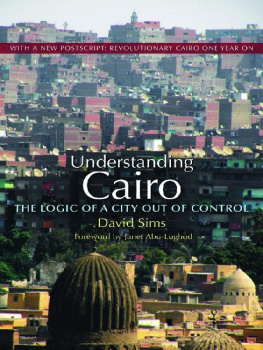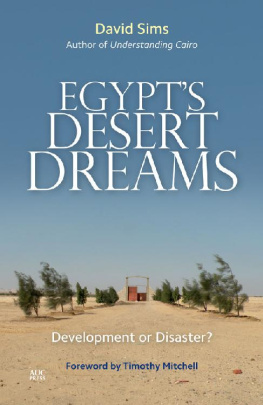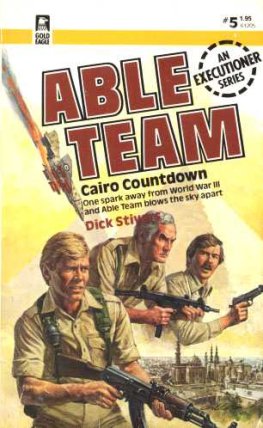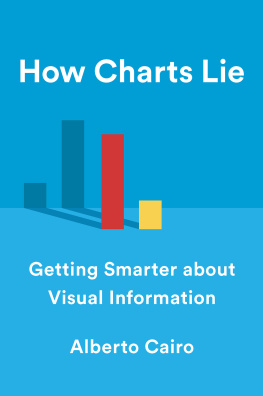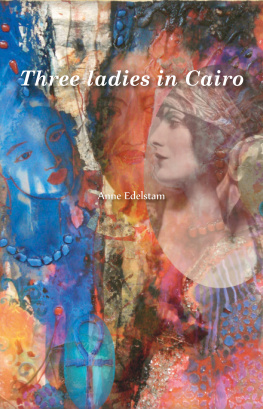Understanding Cairo
First published in 2010 by
The American University in Cairo Press
113 Sharia Kasr el Aini, Cairo, Egypt
420 Fifth Avenue, New York, NY 10018
www.aucpress.com
Copyright 2010 David Sims
All rights reserved. No part of this publication may be reproduced, stored in a retrieval system, or transmitted in any form or by any means, electronic, mechanical, photocopying, recording, or otherwise, without the prior written permission of the publisher.
Dar el Kutub No. 2378/10
ISBN 978 977 416 404 0
Dar el Kutub Cataloging-in-Publication Data
Sims, David
Understanding Cairo: The Logic of a City Out of Control / David Sims.Cairo: The American University in Cairo Press, 2010
p.cm.
ISBN 978 977 416 404 0
1. Cairo (Egypt)Description and Travel I. Title
916.216
1 2 3 4 5 615 14 13 12 11 10
Designed by Adam el-Sehemy
Contents
Map
Figure
Tables
| ADSL | broadband connection |
| AUC | The American University in Cairo |
| CAPMAS | Central Agency for Public Mobilization and Statistics [al-Jihaz al-Markazi li-l-Tabia al-Amma wa-l-Ihsa] (Arab Republic of Egypt) |
| CEDEJ | Centre des Etudes et Documentations conomiques et juridiques (independent French research center in Cairo) |
| CNN | Cable News Network |
| GDP | Gross Domestic Product |
| GOPP | General Organization for Physical Planning (affiliated to MHUUD) (Arab Republic of Egypt) |
| GTZ | Deutsche Gesellschaft fr Technische Zusammenarbeit GmbH (a German federally owned sustainable development organization) |
| HECIS | Household Expenditure, Consumption and Income Survey. See Bibliography under Arab Republic of Egypt, Central Agency for Public Mobilisation and Statistics, Household Expenditure, Consumption and Income Survey. |
| HSUE | Housing Study for Urban Egypt, 2008. See Bibliography under United States Agency for International Development (USAID), Housing Study for Urban Egypt. |
| IAURIF | Institut dAmnagement et dUrbanisme de la Rgion dIle-de-France (French government organization) |
| IDSC | Information Decision Support Center (Arab Republic of Egypt) |
| IGN | Institut Gographique National (French government mapping agency) |
| ILD | Institute for Liberty and Democracy (Lima, Peru) |
| INTA | International New Towns Association (The Hague) |
| JICA | Japanese International Cooperation Agency (government organization) |
| MHUUD | Ministry of Housing, Utilities, and Urban Development (Arab Republic of Egypt) |
| NGO | Nongovernmental Organization |
| NHP | National Housing Program (20052011) (Arab Republic of Egypt) |
| NUCA | New Urban Communities Authority (Arab Republic of Egypt) |
| SEAM | Egyptian Environmental Affairs Agency: Support for Environmental Assessment and Management Programme |
| SME | Small and Micro-Enterprises |
| SPOT | Satellite images from Spot Image S.A. (website: http://www.spotimage.com) |
| SUV | Sports utility vehicle |
| UN | United Nations |
| UN-Habitat | United Nations Programme for Human Settlements |
| UNDP | United Nations Development Programme |
| USAID | United States Agency for International Development |
M any people need to be acknowledged who helped with this book. Warm thanks go first and foremost to Janet Abu-Lughod, who enthusiastically supported the project and made very useful and detailed comments on the text. Next, many thanks are extended to Marion Sjourn for her collaboration in all the cartographical work. Sonja Spruit made valuable contributions with photographs and architectural drawings. Lila Abu-Lughod cheerfully and unstintingly helped with communications.
A number of people shared their knowledge with the author or were colleagues in the work upon which this book rests. These persons included Eric Denis, Ahmed Eweida and Sameh Wahba at the World Bank, Nick Warner, Elena Piffero, Hazem Kamal, Zein Abd Al-Azim, Muna El-Shorbagi, Olivia Kummel, and Hala Bayoumi at the Centre des Etudes et Documentations economiques et juridiques (CEDEJ).
Thanks and gratitude are extended to the people at Google Earth who gave the author permission to use their screen imagery of parts of Greater Cairo.
Thanks must also be extended to the Dutch-Flemish Institute in Cairo, which invited the author to give a lecture on informal Cairo in November 2006, on the basis of which this book project was conceived.
Finally, many thanks are extended to Randi Danforth, Miriam Fahmi, and Nadia Naqib at the American University in Cairo Press, and Lesley Tweddle, whose much appreciated efforts were essential for editing and producing the book.
by Janet Abu-Lughod
C airo is perhaps the city that above all others has captured the hearts of writers and inspired prose ranging from the journalistically sensational to the seriously scholarly. The best of the latter tries to reconcile the citys rich history of religious and political changes with what appears to be the persistent essence of its peoples character. Especially challenging has been the task of describing the protean shape of the city as a coherent geographic whole, since Cairos urbanized region has expanded (and sometimes contracted) over many millennia of political change without losing its centrality or coherence. The exponential growth of Cairos population in the last generation has been matched by radical expansion of the metropolitan regions boundaries. New urban settlement areas have more than doubled the citys extent, absorbing the increased residential population at efficient densities, mostly within the fringe and northern zones.
All fans of Cairo will therefore welcome this new path-breaking book by David Sims, original in its arguments and richly documented with detailed data never before accessible to the general reader. It is clearly a major addition to the voluminous literature about Cairo, thankfully updating and indeed superseding two earlier holistic accounts of the citys social and spatial organization: those written by Marcel Clerget in the early 1930s and by Janet Abu-Lughod in the late 1960s. The sheer size of the citys population and the rapidity with which it has grown in the last century means that the conclusions reached by earlier generations of scholars and the detailed descriptions they crafted, no matter how accurate for their time, have long been in need of updating.
Clergets sympathetic historical narrative, his excellent maps (many of them lovingly hand drawn), and his laborious extraction of raw census data, carried the history of the city up through the height of British colonial rule when a bifurcation of the population into natives and local and foreign elites was sharply reflected geographically in the contrast between the old city and the new. My own book carried the citys history through the overthrow of the figurehead king, the exuberant period of Bandung, Arab Socialism, the nationalization of the Suez Canal, and the construction of the high dam designed to provide cheap electricity for heavy industrial development. It was accompanied by high rates of rural-to-city migration and soaring rates of natural increase, only partially mitigated by significant land reforms to break up enormous feudal estates and by the states ambitious plans to construct industrial zones and mass housing, largely in the northern fringe and on the Giza shore. During this period, sizable parcels of state, military, and waqf (religious endowment) land adjacent to the built-up city were still available for development into popular housing and, later, middle-class projects such as Nasr City and Mohandiseen. These additions, together with the departure of foreigners, helped expand the housing supply to keep pace with in-migration and high natural increase.

